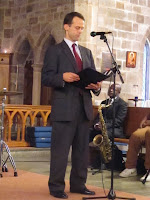 We are writing this “Coming Home” blog some weeks after we
actually said, “hej do” (good-bye) to Stockholm. With unpacking, renewing old friendships,
attending church events, doing yard work and generally re-engaging in our
suburban life, time simply slipped away and a final blog entry never found
life.
We are writing this “Coming Home” blog some weeks after we
actually said, “hej do” (good-bye) to Stockholm. With unpacking, renewing old friendships,
attending church events, doing yard work and generally re-engaging in our
suburban life, time simply slipped away and a final blog entry never found
life.
Assembling final Nordic thoughts was also challenged by Jay’s
return to Scandinavia. Thanksgiving week
was spent in Oslo wrapping up sales work he started before we departed. An Oslo customer asked
Jay to resume the Transition Director role he had turned over to another
manager in June. Jay spent most of December in
Oslo (he's home for the holidays now), but will return until February or March.
 |
| Natalia Brzezinski in pink and Carmen Eriksson, AWC President |
Our departure from Sweden was equally packed with events and
good-byes.
The evening before departing, we attended a reception
sponsored by the American Woman’s Club (AWC) at the US Ambassador’s residence. The reception included the ambassador’s wife
Natalia Brzezinski participating in the award of an AWC scholarship to a young
and aspiring American student. For the
recipient it was the start of new journey. For us it was an opportunity to say good-bye to friends who had become
so dear in such a short time.
 |
| Nina Lagergren in red jacket |
 A few days earlier, we attended our last American Club of Sweden (ACS) cultural forum that commemorated the 100th anniversary
of Raoul Wallenberg’s birth. Wallenberg
was a Swedish humanitarian known worldwide for his tireless efforts to save
Hungarian Jews in the closing years for WW II.
We met Raoul’s sister Nina Lagergren and her extended family who continue
to carry on Wallenberg’s unselfish spirit of service.
A few days earlier, we attended our last American Club of Sweden (ACS) cultural forum that commemorated the 100th anniversary
of Raoul Wallenberg’s birth. Wallenberg
was a Swedish humanitarian known worldwide for his tireless efforts to save
Hungarian Jews in the closing years for WW II.
We met Raoul’s sister Nina Lagergren and her extended family who continue
to carry on Wallenberg’s unselfish spirit of service. .JPG) |
| L-R: Sam Cooley, ACS President, Gunnar Rasmussen and Jay |
Another good-bye was a luncheon with the current ACS
president and good friend Sam Cooley and one of his predecessors from the
1960’s, Gunnar Rasmussen. As club
historian, Jay had read much of Gunnar’s efforts to expand the club’s social
and business presence. As club president, Gunnar hosted visits with notables such
as US Vice President Lyndon Johnson, Sweden’s Prime Minister Olof Palme and
banking tycoon David Rockefeller. Gunnar, despite his 90 years, recalled these events
as though days, not decades, had past.
We should all be so lucky.
 |
| Seared filet of turbot |
 The start of our departure from Sweden was a stay at
Stockholm’s famed Grand Hotel. Beginning in the 1920’s and for 40 years, the ACS
had permanent quarters at the hotel when men (only) drank whiskey and generally
carried on as captains of industry do. The hotel also hosts today’s Nobel
Laureates during their visit to Stockholm. Our names, too, are now on the
hotel’s registry of guests.
The start of our departure from Sweden was a stay at
Stockholm’s famed Grand Hotel. Beginning in the 1920’s and for 40 years, the ACS
had permanent quarters at the hotel when men (only) drank whiskey and generally
carried on as captains of industry do. The hotel also hosts today’s Nobel
Laureates during their visit to Stockholm. Our names, too, are now on the
hotel’s registry of guests.  |
| Salad at the Grand Hotel |
Thank you, Sweden, for all the wonderful friends and
adventures you provided. We are sure another
adventure awaits us somewhere down the road…









































